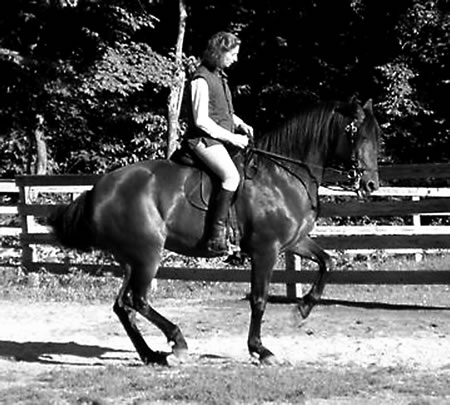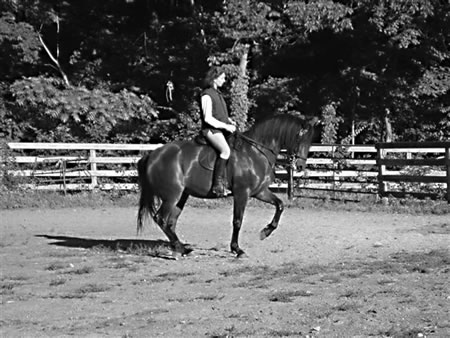Written by Bettina Drummond
This article originally appeared in Eclectic Horseman Issue No.29
Baucherist balance and contact
The title photo illustrates the descente de main and the use of the seat in a circular, kinetic pattern. This Piaffe is used to develop roundness to the hand by releasing both ends of the horse simultaneously into a passive use of the lower back and gives the rider a moment of suspension within which a lift upward can be placed. It provides the throughness in the base of the neck so that if you follow with a transition, you can do so without having the horse lean on the bit. Lightness thus permeates your transition work if the horse is maintained ahead of the leg and under the hand. It is a 19th century chiropractic tool. It is the expression of sensitivity of the rider that produces an internal balance in the horse. It is the moment of freeing into choice to stay with the rider for the horse.
Traditional 18th century balance — a la La Guèriniére

This second photo illustrates a use of the seat like the pendulum of a grandfahter clock. It relies on diagonal seat pressures, opposing the advancement of the leading hip sustaining the diagonal and the retraction of the opposing shoulder to lower the hip angle of the horse. You also bascule the croup with the lower back acting as a lever and the shoulders as a clutch. When you ride the clutch against the lever, you no longer need to provoke diagonal shift with leg pressure. So this piaffe in this balance works on lifting the weight off of the stiffles and lifting the shoulder and forearm release over the maximal point of contact in collection, which is useful to develop lift in flying changes and drive in passage and suspension in medium and extended trot.
It is the cornerstone of classical form and the mark of having successfully completed the foundation of correct gait development and straightness in isometric stretching.
This article originally appeared in Eclectic Horseman Issue No.29


